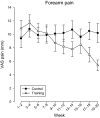Effect of specific resistance training on forearm pain and work disability in industrial technicians: cluster randomised controlled trial
- PMID: 22331386
- PMCID: PMC3282287
- DOI: 10.1136/bmjopen-2011-000412
Effect of specific resistance training on forearm pain and work disability in industrial technicians: cluster randomised controlled trial
Abstract
Objectives: To determine the effect of specific resistance training on forearm pain and work disability in industrial technicians.
Design and setting: Two-armed cluster randomised controlled trial of 20 weeks performed at two industrial production units in Copenhagen, Denmark.
Participants: Working-age industrial technicians both with and without pain and disability.
Interventions: The training group (n=282) performed specific resistance training for the shoulder, neck and arm muscles three times a week. The control group (n=255) was advised to continue normal physical activity.
Outcome: All participants rated forearm pain intensity (Visual Analogue Scale, 0-100 mm) once a week (primary outcome) and replied to a questionnaire on work disability (Disability of the Arm Shoulder and Hand, 0-100) at baseline and follow-up (secondary outcome).
Results: Questionnaires were sent to 854 workers of which 30 (n=282) and 27 (n=255) clusters were randomised to training and control, respectively. Of these, 211 and 237 participants, respectively, responded to the follow-up questionnaire. Intention-to-treat analyses including both individuals with and without pain showed that from baseline to follow-up, pain intensity and work disability decreased more in the training group than in the control group (4-5 on a scale of 0-100, p<0.01-0.001). Among those with pain >30 mm Visual Analogue Scale at baseline (n=54), the OR for complete recovery at follow-up in the training group compared with the control group was 4.6 (95% CI 1.2 to 17.9). Among those with work disability >30 at baseline (n=113), the OR for complete recovery at follow-up in the training group compared with the control group was 6.0 (95% CI 1.8 to 19.8).
Conclusion: Specific resistance training of the shoulder, neck and arm reduces forearm pain and work disability among industrial technicians.
Trial registration number: NCT01071980.
Conflict of interest statement
Figures


Similar articles
-
Effect of Individually Tailored Biopsychosocial Workplace Interventions on Chronic Musculoskeletal Pain and Stress Among Laboratory Technicians: Randomized Controlled Trial.Pain Physician. 2015 Sep-Oct;18(5):459-71. Pain Physician. 2015. PMID: 26431123 Clinical Trial.
-
Effect of two contrasting interventions on upper limb chronic pain and disability: a randomized controlled trial.Pain Physician. 2014 Mar-Apr;17(2):145-54. Pain Physician. 2014. PMID: 24658475 Clinical Trial.
-
Implementation of neck/shoulder exercises for pain relief among industrial workers: a randomized controlled trial.BMC Musculoskelet Disord. 2011 Sep 21;12:205. doi: 10.1186/1471-2474-12-205. BMC Musculoskelet Disord. 2011. PMID: 21936939 Free PMC article. Clinical Trial.
-
Time-wise change in neck pain in response to rehabilitation with specific resistance training: implications for exercise prescription.PLoS One. 2014 Apr 7;9(4):e93867. doi: 10.1371/journal.pone.0093867. eCollection 2014. PLoS One. 2014. PMID: 24709874 Free PMC article. Clinical Trial.
-
Workplace interventions for increasing standing or walking for decreasing musculoskeletal symptoms in sedentary workers.Cochrane Database Syst Rev. 2019 Nov 17;2019(11):CD012487. doi: 10.1002/14651858.CD012487.pub2. Cochrane Database Syst Rev. 2019. PMID: 31742666 Free PMC article.
Cited by
-
High intensity physical exercise and pain in the neck and upper limb among slaughterhouse workers: cross-sectional study.Biomed Res Int. 2014;2014:218546. doi: 10.1155/2014/218546. Epub 2014 Jan 9. Biomed Res Int. 2014. PMID: 24527440 Free PMC article.
-
The effect of double versus single oscillating exercise devices on trunk and limb muscle activation.Int J Sports Phys Ther. 2013 Aug;8(4):370-80. Int J Sports Phys Ther. 2013. PMID: 24175124 Free PMC article.
-
Implementation of specific strength training among industrial laboratory technicians: long-term effects on back, neck and upper extremity pain.BMC Musculoskelet Disord. 2013 Oct 9;14:287. doi: 10.1186/1471-2474-14-287. BMC Musculoskelet Disord. 2013. PMID: 24106771 Free PMC article. Clinical Trial.
-
Efficacy of 'Tailored Physical Activity' or 'Chronic Pain Self-Management Program' on return to work for sick-listed citizens: design of a randomised controlled trial.BMC Public Health. 2013 Jan 23;13:66. doi: 10.1186/1471-2458-13-66. BMC Public Health. 2013. PMID: 23343386 Free PMC article. Clinical Trial.
-
Effect of individually tailored biopsychosocial workplace interventions on chronic musculoskeletal pain, stress and work ability among laboratory technicians: randomized controlled trial protocol.BMC Musculoskelet Disord. 2014 Dec 18;15:444. doi: 10.1186/1471-2474-15-444. BMC Musculoskelet Disord. 2014. PMID: 25519844 Free PMC article. Clinical Trial.
References
-
- Andersen LL, Mortensen OS, Hansen JV, et al. A prospective cohort study on severe pain as a risk factor for long-term sickness absence in blue- and white-collar workers. Occup Environ Med 2011;68:590–2 - PubMed
-
- Punnett L, Wegman DH. Work-related musculoskeletal disorders: the epidemiologic evidence and the debate. J Electromyogr Kinesiol 2004;14:13–23 - PubMed
-
- Baldwin ML. Reducing the costs of work-related musculoskeletal disorders: targeting strategies to chronic disability cases. J Electromyogr Kinesiol 2004;14:33–41 - PubMed
-
- Nahit ES, Taylor S, Hunt IM, et al. Predicting the onset of forearm pain: a prospective study across 12 occupational groups. Arthritis Rheum 2003;49:519–25 - PubMed
-
- Fan ZJ, Silverstein BA, Bao S, et al. Quantitative exposure-response relations between physical workload and prevalence of lateral epicondylitis in a working population. Am J Ind Med 2009;52:479–90 - PubMed
Associated data
LinkOut - more resources
Full Text Sources
Medical
